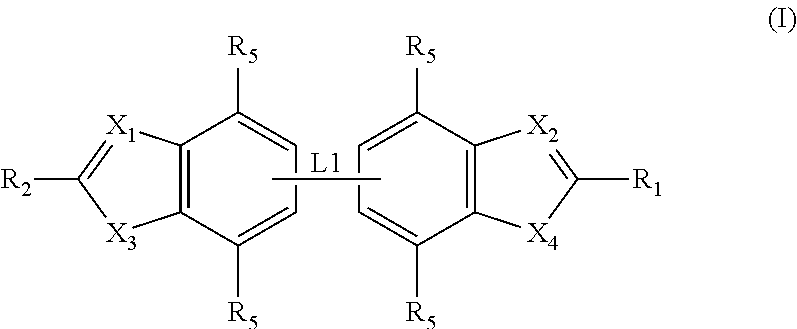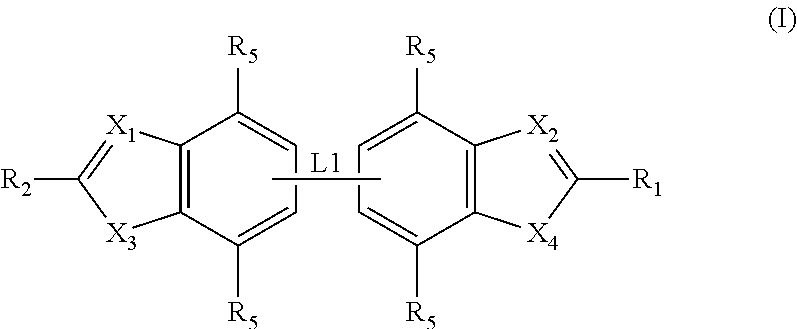Antibacterial compounds
a technology of compounds and compounds, applied in the field of compounds, can solve the problems of not being able to disclose the activity of anaerobic spore-forming bacteria, and the general formula of documents not being able to disclose compounds, etc., to achieve the effect of increasing the activity, enhancing the other biological activities of the compound, and increasing the melting poin
- Summary
- Abstract
- Description
- Claims
- Application Information
AI Technical Summary
Benefits of technology
Problems solved by technology
Method used
Image
Examples
example 1
(a) Example 1
Preparation of Compounds of General Formula (I)
(i) General Experimental
[0291]HPLC-UV-MS was performed on a Gilson 321 HPLC with detection performed by a Gilson 170 DAD and a Finnigan AQA mass spectrometer operating in electrospray ionisation mode. The HPLC column used is a Phenomenex Gemini C18 150×4.6 mm or a Phenomenex Gemini C18 50×4.6 mm 3μ. Preparative HPLC was performed on a Gilson 321 with detection performed by a Gilson 170 DAD. Fractions were collected using a Gilson 215 fraction collector. The preparative HPLC column used is a Phenomenex Gemini C18 150×10 mm and the mobile phase is acetonitrile / water.
[0292]1H NMR spectra were recorded on a Bruker instrument operating at 300 MHz. NMR spectra were obtained as CDCl3 or DMSO-d6 solutions (reported in ppm), using chloroform as the reference standard (7.26 ppm) or DMSO-d6 (2.50 ppm). When peak multiplicities are reported, the following abbreviations are used s (singlet), d (doublet), t (triplet), m (multiplet), br (...
example 2
(b) Example 2
Activity of the Compounds of the Invention Against C. difficile
[0340]A list of preferred compounds of general formula (I) together with their minimum inhibitory concentration (MIC) against Clostridium difficile ATCC700057 and a Clostridium difficile clinical isolate (CI) is summarized in Table 2 (below):
TABLE 2CompoundMICMICnumber(ATCC700057)(CI)1++++++2+++++3++++++4++5+++++6+++++7++++++8++++9+++++10++++++11++++++12++++++In the above table, the symbols used to indicate the MIC values are:+++ = ++ = 1-16 μg / mL+ = 17-64 μg / mL− = >64 μg / mL
example 3
(c) Example 3
Activity of the Compounds of the Invention Against C. perfringens
[0341]A list of compounds together with their minimum inhibitory concentration (MIC) against Clostridium perfringens ATCC13124 and a Clostridium perfringens clinical isolate (CI) is summarized in Table 3 (below). The symbols used to indicate the MIC values are as for Table 2 (above).
TABLE 3CompoundMICMICnumber(ATCC13124)(CI)1++++++2−−3++++4−−5++++6++++7++++++8+++9+++10+++++11+−12−−
PUM
| Property | Measurement | Unit |
|---|---|---|
| Composition | aaaaa | aaaaa |
| Antimicrobial properties | aaaaa | aaaaa |
| Selectivity | aaaaa | aaaaa |
Abstract
Description
Claims
Application Information
 Login to View More
Login to View More - R&D
- Intellectual Property
- Life Sciences
- Materials
- Tech Scout
- Unparalleled Data Quality
- Higher Quality Content
- 60% Fewer Hallucinations
Browse by: Latest US Patents, China's latest patents, Technical Efficacy Thesaurus, Application Domain, Technology Topic, Popular Technical Reports.
© 2025 PatSnap. All rights reserved.Legal|Privacy policy|Modern Slavery Act Transparency Statement|Sitemap|About US| Contact US: help@patsnap.com



